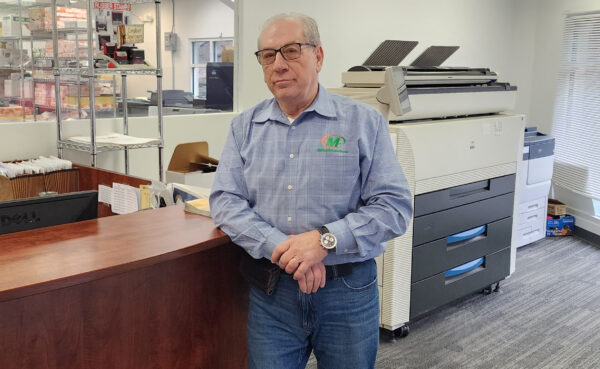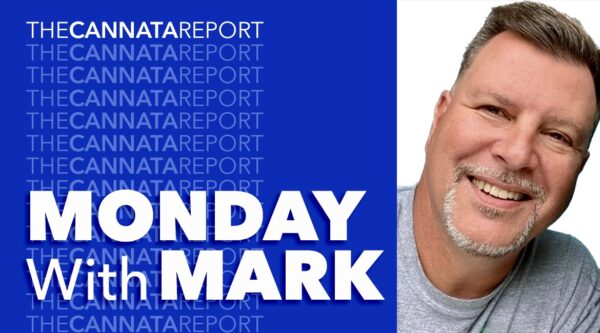After nearly 40 years at the helm, Mark Michelson passed the torch this past fall as Printing Impressions’ editor-in-chief and content director. But the printing industry’s longtime voice hasn’t gone away completely.
Publisher’s note: EIC Mark Vruno has known Mark Michelson professionally for nearly half of the latter’s amazing career. When Vruno was editor of Graphic Arts Monthly and Printing News, they traveled the world together on media junkets and tradeshow circuits. Mark V. says he respects the ‘other Mark’ as a formidable yet always friendly competitor: “We fought for news ‘scoops,’ sure, but Mark is way too nice of a guy to dislike!”
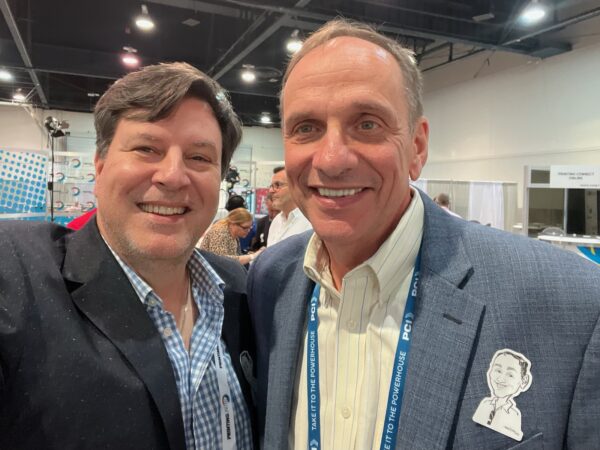
Two Marks: Vruno (left) and Michelson at the PRINTING United Expo this past autumn.
It, simply, was time. That essentially was Mark Michelson’s response when I asked him why, at age 67, he decided to step away as the full-time editor-in-chief of Printing Impressions (PI), NAPCO Media’s flagship magazine brand—the job he has been doing since 1985. Having known him for the past 20 years, the full explanation comes as no surprise to me: Michelson didn’t just pack up his desk and walk out the door on September 30th (his last official work day). No, “I wanted to ensure a smooth transition,” he explains. Truth is, succession planning had been in the works since 2023, when he internally announced his timeline to retire.
Having been such a major part of his life for so many years, it stands to reason that Michelson genuinely cares about the NAPCO brand and, in turn, the printing industry. In his own words: “I nurtured PI like a child, and it became a part of me.” His presence at drupa last spring and, more recently, at the PRINTING United Expo was the culmination of a decade’s worth of mentoring on behalf of PI’s newly named Content Director Ashley Roberts, who Michelsen himself hired nearly 10 years ago. “Ashley is a rising star,” he praises. “She’s a talented young lady who brings new ideas and energy.” In Düsseldorf and Las Vegas, the duo was seen together walking the show floors, popping in and out of booth after booth, making important introductions and bidding final adieus.
Filled with too many handshakes and hugs to count, the 2024 edition of the North American tradeshow last fall served as a farewell tour. On September 11, a surprise retirement reception was held in Mark’s honor. There were toasts and speeches and video memories shared. The whole experience “was emotionally draining,” Michelson declares with a deep sigh. The surplus of free time has been treating him well so far these past seven months but, as it turns out, retirement is only a part-time “gig.” The longtime scribe of the printing industry will continue to exert his influence in various ways by writing and commenting (“on a 1099 basis”) as an independent contractor for NAPCO.
In a two-hour interview, Michelson shared his thoughts about private-equity investment, technological advancement, ongoing supplier/PSP consolidation, the industry’s past misogyny and several other topics germane to printing as the medium advances into the second quarter of the 21st Century:
PE now means private equity (not printer’s error)
While the long-term “jury” is still out regarding the amount of private equity (PE) investors buying up printing companies, Michelson believes such acquisitions aren’t necessarily a bad trend and, ultimately, will have a profound affect. PE strategies generally involve investing in companies that are not publicly traded on stock exchanges. These fund managers, also known as general partners, often seek to generate returns by enhancing the performance of their portfolio firms over the course of their holding period.
“On the positive side, there are committed PE people bringing more automation, technology, business management, and skill sets into our industry,” he points out. Such investment also can provide an exit strategy for owners wishing to cash out and retire. “It’s sad because small, ‘mom-and-pop’ shops once were the bedrock of the U.S. printing industry, but there are less and less of them,” Michelson laments. For the most part, “the younger generation doesn’t want to take over these family businesses.”
Contrary to some popular speculation, there has not been a rash of slash-and-burn tactics used by private equity groups. “It’s not all ‘cut, cut, cut!’” observes Michelson. Margins for print may not be as high as in some other businesses, but “stable cash flow is appealing.” On the other hand, the lion’s share of PE players can be impatient and don’t typically stay in the print game for the long run. “Down the line, what happens after companies have been flipped three or four times?” Michelson asks. “We will find out.”
Top 5 tech advancements since 1982:
When asked to identify key technological developments during his tenure, Michelson came up with this list:
- Computer-to-plate (CTP) technology—“Creo’s platesetters were on the forefront of that development,” he remembers.
- The advent of desktop publishing was a game changer that “eventually wiped out the entire typesetting industry.”
- The adoption of digital printing was gradual, Michelson relates, happening over time (see below). The print-on-demand train started rolling slowly, he notes. Amid glitches, “the shift to digital print didn’t catch on as fast as pundits thought it would.” Soon enough, though, the digi-locomotive picked up speed! Milestones included Xerox’s introduction of its Docutech in the early 1990s and, a few years later, Benny Landa’s Indigo Digital Press, which HP would acquire.
- Web-to-print streamlined the ordering process and changed the way in which printers sell their products online.
- Automation: eliminating human-controlled processes.
Why were so many conventional, sheetfed-offset printers hesitant to embrace digital output? A large part of the reason was that many of them had huge investments in offset presses that were built to last, Michelson opines. Aside from capital equipment being paid off, he believes the resistance was mostly because of a perceived low-quality issue. In a lot of cases, he thinks printers maintaining “manufacturing mindsets” cared about critical color matching more than their customers actually did: As recently as 15 years ago, “high-end, boutique printers like Anderson, Hennegan, and Williamson took great pride in their work—and rightly so!”
A love affair with printing
Michelson and printing have come a long way since his journey began in the early 1980s. Bright eyed and bushy tailed in 1979, he came to the industry armed with a journalism degree from Northern Illinois University in DeKalb, the town in which he grew up. “Four generations of my family now have graduated from NIU,” he proudly announces. His first gig out of college was as a cub reporter covering three small Illinois towns for a weekly newspaper chain. “They had a Compugraphic typesetting system in the office but there was no way yet to transmit files [electronically],” he recalls. A driver picked up computer disks to physically transport them; page layouts literally were pasted up manually.
Looking back at his lanky (standing almost 6’5” tall), 24-year-old self, Michelson remembers when NAPCO owner Irv Borowsky “ran the show” and writers filed stories on electronic typewriters. The old Broad Street building in Philadelphia was so cold and drafty that he typed away wearing gloves in the winter! In a three-year span early in his career, he moved from an assistant editor on Package Printing magazine (where he also was tasked with print advertising production) to editor of a title called Worldwide Printer and then El Arte Tipográfico, which was translated into Spanish. “I didn’t know the language, so I had to proofread the gallies letter for letter,” he laughs.
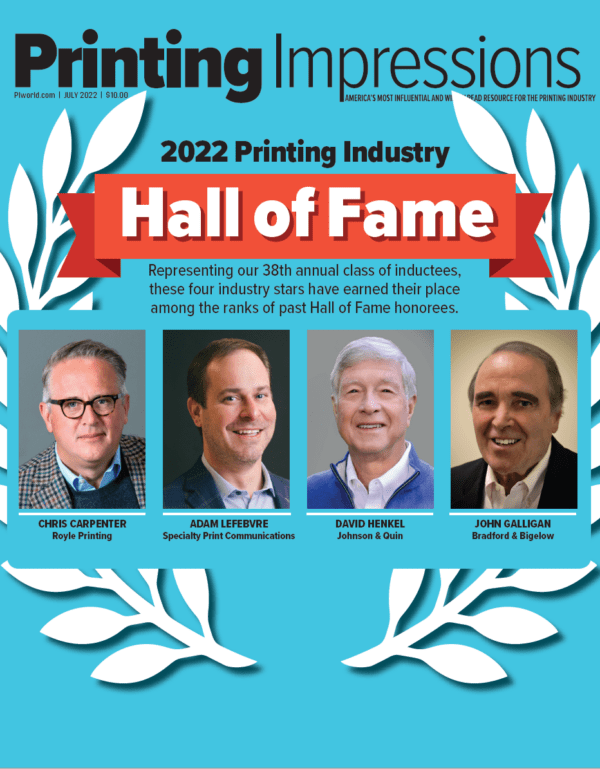
One of PI’s recent HOF issues in print.
His big break with PI came in ’85, when John Conner became the publisher and Michelson ascended to editor of the flagship publication. He would see the magazine grow to employ an entire staff and require a monthly print run of 100,000 copies. (By comparison, only 35,000 were printed in 2024.) In its heyday, when print was king before the Internet, PI expanded to well over 100 pages. “We’d have 10 to 15 features [feature stories] in the magazine,” Michelson reports.
The elder Borowsky was “creative and entrepreneurial,” but he often shot from the proverbial hip and did not like people to challenge him. He could be a difficult person to work for, Michelson admits. However, the two men struck a common chord when it came to business. “You have to understand that Irv was an idea man, and PI was his ‘baby.’ I learned that he wasn’t very good at creating business plans,” he continues. “Things were always changing!” But the young editor apparently had the right temperament. “I admired him, and he gave me opportunities and advice.”
When television became a popular media technology in the late 1940s, Borowsky had started up a regional publication called TV Digest. In ’53 he sold his TV magazine to Walter Annenberg and TV Guide, then used the proceeds to found North American Publishing Co. (NAPCO) some five years later. “Irv built the company around Printing Impressions,” Michelson says, adding that PI started out as a regional newspaper and quickly morphed into a national tabloid.
Print’s ‘Big 3’ mags
“Believe it or not, there were 12 magazines in the [printing] field at that time,” he notes. The respected leader was Graphic Arts Monthly (GAM), which had been around since 1929 and was acquired by Cahners Publishing in 1986. When Michelson came along,“Graphic Arts Monthly had the ‘editorial dream team’ of Roger Ynostroza, Peter Johnston, Earl Wilkens and, later, Bill Esler,” he recollects. “They were well-known industry figures at the time, . . . and GAM was the automatic [ad] buy.”
American Printer (AP) was even older, with roots dating back to 1883. Known best for its overall business coverage, AP once was counted among the “Big 3” national trade magazines and had brought in a trail-blazing female editor named Jill Roth around the same time as Michelson at PI. GAM, meanwhile, tried to seize the print/technology angle, while PI’s focus was on executive profiles. Copies of those three publications were prominently displayed on coffee tables in reception lobbies of just about every printing firm around the country. Later in the 20th Century, other trade journals, including Innes Publishing’s High Volume Printing (HVP), joined the media fray. (Printing News remained regional, in the U.S. Northeast, until 2011, and now is part of WhatTheyThink/APTech.)
Some printing industry competitors were of the cut-throat variety and downright ornery. Late, longtime GAM Publisher Dick Vinocur could be cantankerous, according to numerous accounts. “Dick had been critical of Regis Delmontagne,” who served for more than 25 years as chief executive of NPES (the Association for Suppliers of Printing, Publishing and Converting Technologies), Michelson relates. “When Vinocur had success with his Vue/Point vendor-user exchange [in the early 1990s], Regis bought it for the sole purpose of killing it [off].”
On the friendlier side, for 22 years (1997-2019), the late Katherine O’Brien (“KOB”) served in editorial capacities (mostly as chief editor) at AP. After a long, valiant fight with breast cancer, the witty editor passed away in 2021. “Katherine was a sweet lady and very talented,” reflects Michelson. “She was accepted by printing’s ‘good-old-boy network.’” During that time period, PI featured primarily “middle-aged white guys” on its front covers, he continues. “The industry has progressed with regard to women and minorities but still has a long way to go.”
Aging mentors dying off and younger peers passing away from disease is the curse of a career as long as Michelson’s. Equally tall colleague Mark Smith, PI’s technology editor, continued to work during chemotherapy treatments before succumbing to mouth cancer, despite never smoking, in early 2013. Smith had moved to Philly (from the Chicago area) to take the NAPCO job. A bit of a loner, he possessed a brilliant mind, according to Michelson: “Mark was a visionary in a lot of ways, especially around internet-related subjects. This was pre-SEO [search engine optimization] . . . .”
The print medium in 2035?
Looking into his “magical crystal ball,” he adds that it will be interesting to see how the rapid pace of artificial intelligence (AI) developments will change the printing industry. “A lot of printers are using embedded AI and don’t even know it,” Michelsen observes, adding that AI’s impact will be “huge.” He also has his eyes keenly focused on three other areas of concern:
- The United States Postal Service: For print traveling in the U.S. mailstream, how can postage rates continue to rise amid poorer delivery standards? “[Media] buyers are analyzing the costs,” Michelson warns.
- Data privacy laws: There is a downside to the personalization of data, so keep track of what’s going on in Europe and California, he urges.
- The ongoing labor shortage: How can we attract younger people to the printing industry to replace workers who are aging out? “This is not an easy one,” Michelson says. “There’s not one answer.” He does believe, however, that more grassroots efforts are part of the solution. Also, post-COVID-19, the entire collegiate system as we’ve known it comes into question. As more education coursework migrates online, Michelson wonders if younger people may have more opportunities to learn “blue-collar” trade skills virtually.
Then, there are the industry shrinkage concerns. Consolidation among equipment suppliers has been going on for decades. “There are too many players on the digital press manufacturer side,” Michelson suggests, “and maybe on the offset side.” More recently, consolidation has resulted in huge changes for the paper industry as mills shift away from producing commercial grades, which are deemed as less profitable (as opposed to, say, tissue and packaging papers). This leads to fewer choices for printers and their customers. And, on the PSP (“print service provider”) side, 40-plus years ago there were some 65,000 printing firms in the United States. “Now, there are about 20,000,” he reports. “We’re seeing consolidating among the packaging and label ranks as well.”
The printing industry’s trade associations have consolidated, too. Some of us remember the International Prepress Assn., National Assn. of Printers & Lithographers (NAPL), the aforementioned NPES, Printing Industries of America (PIA), Specialty Graphic Imaging Assn. (SGIA), and R&E (Research & Engineering) Council. Michelson believes that the five-year-old PRINTING United Alliance is successfully evolving with the changing times and the nominal, $400 annual membership dues are a worthwhile investment. From sustainability to legislative initiatives, “printing needs a singular voice to steer the boat in the same direction,” Michelson admonishes. “Different, fragmented factions are not healthy for our future,” he says of the industry he has come to love.
Going forward, how much of NAPCO’s flagship printed products stay in the company’s revenue mix remains to be seen. With content now more focused on videos, webinars, podcasts, daily e-newsletters, custom publishing and events, Michelson acknowledges that traditional “print products generate less revenue” than they once did. He notes, however, that publications can drive audiences to peer events, citing the recent Inkjet Summit as a prime example. While at the event in Florida, Mark asked Marco Boer of consultancy IT Strategies about tariffs, which could be a boon for digital and inkjet printing. Similar events have been created around the digital packaging, wide-format print and apparel segments.
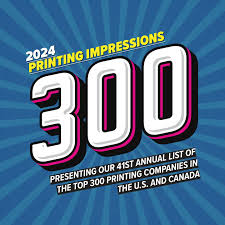
3 PI Milestone Memories
- Michelson created the Printing Industry Hall of Fame and remembers when 1,200 people packed the Chicago Hilton Ballroom for an induction ceremony 30-odd years ago during GRAPH EXPO.
- He also remembers when the annual PI 300 ranking of the nation’s largest printing firms (by sales) was known as the PI 500. “It was a huge under-taking and a boot-strap operation in the early days with a lot of reaching out and calling people … faxing them” before email, he says. The 2023 list marked its 40th. Watch for the next ranking coming in July!
- Pre-Google era, another beastly project was PI’s annual “Master Specifier” list, which featured equipment specs from suppliers every summer. “It was more than a ‘Buyer’s Guide,” Michelson says, adding that one year the issue fetched more than $1 million worth of advertising sales. “It was a ‘cash cow’ that died a slow death.”


